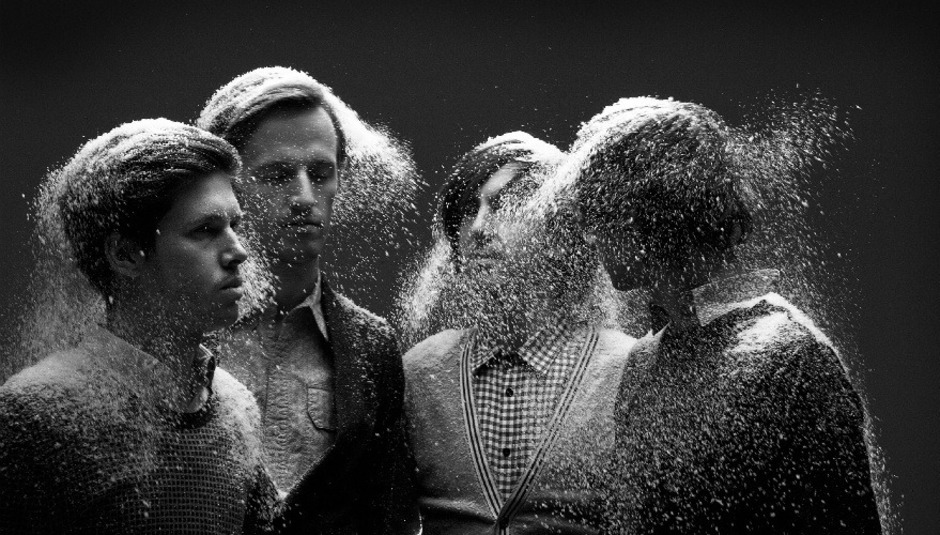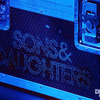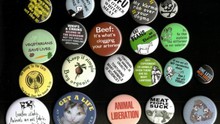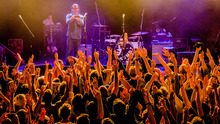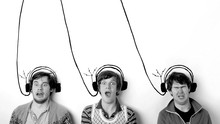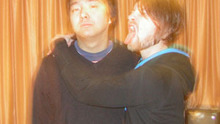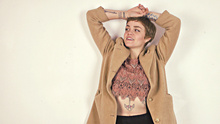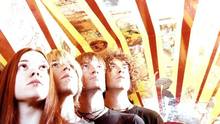DiS founder Sean Adams chats to Cut Copy, about making one of the albums of the year, Zonoscope, ahead of their performance at Wireless in Hyde Park on Sunday...
A lone pigeon nibbles the grey ground at our feet. Its dirty beak pecks away at my ginger cake crumbs as I sip a flat-white coffee with Dan Whitford and Tim Hoey. The sky-rat is listening in on our conversation about Cut Copy’s triumphant third record, Zonoscope, which they’re currently deep into the campaign trail for.
Touring the world in support of their beautifully bangin' new album is a bit odd, especially when they can’t take weekdays off. “It’s not really a Sunday night sort of record.” explains guitarist Tim Hoey. “It was a little bit strange playing it [in London on a Sunday night earlier this year] but when you’re travelling around the world, days and weeks and weekends sort of lose a little bit of meaning. It’s either a show day or a travel day, and it seems like a Friday or Saturday, every day.” And what a show that gig at the Forum was. Gone were the scruffy guys in t-shirts, flicking their fringes and hoping a few people might know the words. In their place were a bunch of suited chaps, looking out at a sweaty mob, hanging onto every (heart)beat. A sea of arms aloft, as minds were lost in the ebb of the spacey synths. They woah-ooh-ooooh-oh and uh-uh and woo!, and sometimes even clap in the right places. As the lights surveyed the room, it was clear that nearly every pair of eyes were closed and lips are ajar, as the whirl-of-it-all swept our collective cares away. Slowly but surely, as the gig marched forth, the undeniable rhythms, flowing along the strobing green corridors of our minds, reached a point of pure euphoria and something, sort of, er, transcendental happened...
Throughout the show, in the corner of my eyes, in the dark below, dirty trainers bounce up and down and high heels flick from side to side, chasing the pounding pulse. Yet for all the care-free glee and excitement, there were also gaggles of people squishing up their faces and gazing confusedly centre stage at a ruddy big door. Which begs the question: the white door, is that like The Wall? “If you put the door and the wall together that would make perfect sense!” quips Dan Whitford, thankfully picking up on the Pink Floyd reference. He continues: “It was kind of this idea we had to make the shows a little bit different to what we’ve done in the past, so that it wasn’t a traditional rock show or the club-rave thing. We wanted to have elements of those things but we’ve added props to the stage, to make it more like an installation, to make it more special.” Tim adds: “It’s interesting to see people’s faces when the door is unveiled. And how confused they look. It takes people by surprise. And then it becomes a video surface, so it’s multi-purpose.” The door is huge, towering a good 6ft or more above the band members heads as they stepped through it. Must be a right ball-ache getting it on a plane: “It’s a bit of a challenge to take it around the world, yeah,” winces Tim, probably thinking about helping out with the lugging. “There are, like, 8 people moving it. It’s pretty much like moving a grand piano, it’s about as heavy.”
The screen on the door featured things like disco lights, forests and fiery scenes of devastation, contrasting technology with the power of nature, and also the force man-made machines can have on the planet. It seems less like some preachy save the planet posturing, and more so, a representation of the bands fusion of the organic roots of the past and the synthetic suss of the future. Then again, I can’t help thinking that some of the slo-mo nuclear explosions, are a cheeky metaphor for the band’s overnight success...? “Not really but I know what you mean.” laughs Dan. “It’s six or seven years since we started and its been a gradual build, for sure. We didn’t really have a big break-out first record and weren’t playing massive shows from the beginning. And we’ve done it the old skool way, touring hard.” Tim chimes in: “It’s good in a way, I guess, because especially in the UK things get a real push for about fifteen minutes and disappear off the face of the earth, soon after. They come crashing down as fast as they were pushed up and hyped. I guess what we’ve done is a bit more genuine and we’ve been lucky enough to build a fanbase and stuff like that.”
Were things different for you in the UK to the rest of the world, particularly with the impact of blog culture in the US? “Yeah, from the beginning blog culture has been really kind to us. Like, in New York we can play three or four nights at a venue the size of The Forum in London. I guess it’s grown more quickly in the US because of blogs and sites like Pitchfork,” Dan pauses, unsure if that’s a taboo subject but the P-word is fine in my company - that Ryan and his lot are good people, mad respect etc - so I signal him along “...and maybe the style of music, as well as the blog phenomenon itself. For whatever reason our band has found a pretty strong fanbase in the states, and each time we go back things grow, which isn’t the same everywhere for us.”
In prepping for the interview, I was surprised to find that the Zono prefix of the album title isn’t actually a word that means anything. Google found a Japanese restaurant, and I learnt that Sono means Garden in Japanese, however it seems to be some bastardized neologism. “We were attracted to creating a new word for the record,” says Dan. “It felt like there was a theme or quality to some of the tracks that was exotic, like a far away location because of all the psychedelic, far-out sounds. The album felt like it needed some new word to be coined. We wanted it to be a new way of seeing this world” So it wasn’t to make it easier to find on Google? “Ha, no, I wish I was being smart like that but I realised later. I don’t think we even got the dot-com, unfortunately. I imagine some fan got that?”
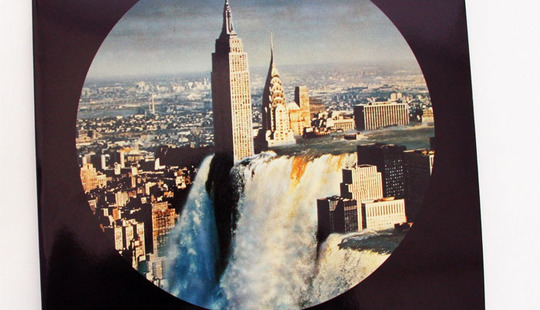
Moving from the title to the much talked about record cover (above) by Japanese photomontage artist Tsunehisa Kimura. Whilst it seems quite a surface observation to judge the band by their record sleeves (and awesome t-shirts), design does seems incredibly central to Cut Copy's music. It's not just aesthetic, it's almost as if some of their songs are more like ornate architectural structures, rather than anything like the adroit synth-pop of many of their contemporaries. It’s little surprise then to discover Dan used to be a full-time graphic designer (he still co-runs Altar) “It was always sort of like a side-project doing music,” states Dan. “I think that’s the same for all of us. Even touring the first record we were all doing other things. Tim was studying fine art, Mitchell is a web programmer, so design was my job and music was the fun things I was doing at weekends. I think, slowly, balance has shifted to now and I’m a 100% music. I guess having other jobs took the pressure off and maybe, in some ways, gave us the luxury of focusing on the creative side of what we do, rather than on putting food on the table.” Oddly, lots of bands think they need to quit their day jobs and dedicate their lives to music, but that isn't always for the best, as Tim agrees: “I think having a diverse outlook on things doesn’t hurt either. The idea of being 19 or 20, if all that you want to do in your life is pursue music, isn’t a well-rounded outlook on life and perhaps isn’t really positive for creativity.”
There are a lot of awful buzz-words flying around in the ether at the moment, which try to make sense of straddling of worlds and mediums. It's all the rage, in certain circles, to talk about magazines as being bi-media, because they exist in print and online, and TV shows like X Factor being transmedia, because they intersect with the internet, and are often shaped by audience participation or are only fun because the commentary on Twitter, which becomes a whole new sort of collectivism. Our ability to dive deep into plots, and to immerse ourselves in hyper-complex narratives, like Lost or The Killing, or decode GirlTalk albums, are completely at odds with talk of the web making us increasingly shallow, and inattentive. The same shifts haven't really trickled into music but then there's always been an element of deciphering the cryptic lyrics and understanding the relationship between the imagery, the videos and the sounds. I've been fascinated by minimal techno hero Ricardo Villalobos (graphic designer), Ian from LostProphets (graphic designer) and Gerard Way with his comics and whether you can hear or feel the influence of that in the music. Like the ways in which you can hear some of the Germanic design influences seeping into Cut Copy's music. “Definitely, they're there," Dan assures me. "I think any music that has quality, beyond just songs, like Beck, doing conceptual art with his uncle or Cornelius, does amazing conceptual art as well. KLF are the perfect example. I always find that other-side of things really interesting, as there’s something to digest beyond listening to the songs. You can think of music as being an art-form, and have other aspects to it, in the artwork and performance, which adds a whole other dimension for people. I guess it had an influence coming from a design background but we’re all creative people and we like all sorts of different artforms, as well as music.”
So the Zonoscope cover art, with the rusty water pouring down the side of the Empire State building, I guess it isn’t as blatant as being a global warming warning about water levels rising in Manhattan? “It’s probably not as literal as that. Hah. It’s kind of a surreal image. For me it represents, a balance of man and nature, and this super, kind of, man-made cityscape, this majestic thing, and then equally, a much more natural, organic, co-existence, in this surreal space. There’s some sort of similarity between that and making our album because on the one hand there’s trains going past and this cityscape, and also tropical birds flying past and at times we felt deep in the jungle with these tribal rhythms and beats. The artwork sort of encapsulates the record for me. I think it’s actually from Niagra falls. It’s quite timeless as it was made in the 70s by the artist, The timelessness was the whole idea, referencing movements in music and art, re-imagined in a modern context, so it hopefully works on those levels as well.”
The future in the 80s had so much more fear and excitement, do you think we’ve kind of lost that? And now that we live in the time when films in the eighties were set, and maybe we haven’t had those promises fulfilled? “In modern music there’s so many things going on," says Dan, thoughtfully gazing off into the distance for the first time since we've started talking. "There are so many styles but it’s all coming from a place you’re familiar with, because you’ve lived through it. In the here and now, you know where people are coming from with a new sound or style and you can understand it. When you listen to an older record, sometimes things from that time or that place are cultural, and they aren’t as familiar to you. When you listen to a record from the sixties or something, for me it’s a little more inspiring because it’s not the time you’ve lived in. With our music, we often take an idea from the seventies and project it forward. I mean, imagine if the biggest band in the early seventies was Can, and what would the music of now be like, if they were The Beatles.” Tim adds "I think we've actually written a song around that very concept, I forget which." Like if in ‘77 Eno’s Music for Airports was as big as Never Mind the Bollocks? “Totally, yeah! I guess that’s why I like the idea of timelessness with music, because old ideas and new ideas can co-exist and have weird children together.. deformed children, maybe.”
In terms of influences with Zonoscope, the band mentioned Fleetwood Mac's Tusk in an early interview, and there seems to be some Talking Heads in there. And, er, Men at Work? “Hah, yeah.” laughs Tim “it’s been mentioned... It’s so funny, because we never thought that. When people first said that, we hadn’t listened to that song for ages. I didn’t know what they meant about ‘Take Me Over’. I was like ‘I don’t know what the hell you’re talking about’. So we went back and listened to that Men at Work track, and it’s mainly just the resolving notes on the bassline, it does a similar kind of der-nur-nuh thing. It’s funny how people interpret things. I guess going back to what we were just saying, there was a period in the 80s when music was really influences by, like, African culture, specially the kind of rhythmic sounds coming from there at the time. Like Eno, Byrne, collaboration Bush of Ghosts and also Paul Simon’s Graceland, and Trevor Horn produced great stuff like Graces Jones.” Dan jumps in and enthuses “and Malcolm McLaren’s Duck Rock which is one of my all-time favourite albums. I think that was quite a big influence on Zonoscope. But there was also an influence on this record, old skool Chicago House stuff, and we spent a lot of time going back to the primitive kind of synthesised kind of percussion stuff, which is on the other side of the African rhythms. I guess also psychedelic stuff, like Happy Mondays and Primal Scream, kind of post-house, from the UK. A myriad of influences..." Everything you've ever listened to? "Yeah, pretty much everything we’ve ever listened to.”
At this point, the lone pigeon at our feet looks up, as if to say he's finished my scraps and is bored of listening to the drone of my voice. And then something truly disturbing happens. A whole flock of pigeons swarm at us, like a scene from The Birds. This carries on for three or four minutes, with the birds moving majestically through the park. They swoop toward my dictaphone and after a few minutes of the sky-rats reflecting off the dark lenses of his glasses, Tim tries to get his camera out, and suddenly, they stop. Tim says "It's a real shame this isn't a video interview, that was incredible." We sit, a little breathless. My mind wanders, pondering whether these birds were by their PR who is nowhere to be seen, to make me think about the power of nature and how Dan has grown the band from a bedroom project, labouring over a hot laptop and creating a haze of dreamscapes all those years ago. The band then formed, toured and toured, and the venues grew larger and larger. This saw a shift from bedroom indulgence to needing to entertaining audiences. I know they're not actually able to control nature and bring these birds to illustrate this point, so I try to bring things back to my list of questions... Did context, in terms of creation and people’s consumption hearing it live, in bigger theatres, influence this album, Dan? “For sure. I think having some confidence in the idea we were working on, in terms of the studio being a place, like another world, and giving it that sense of grand space, which the album inhabits. Whereas I guess the first album does sound like a dude in his bedroom, and it does sound introverted, I guess. We were much more confident making this album.”
Did you feel it was important to use ‘real instruments’ rather than faking it on laptops with this album? Like I hear you used some water bottles to make percussion sounds, was that an ambient influence... “It actually came from Can’t Stop You Can’t Get Enough, the Michael Jackson song, well the idea did. But yeah, certainly the more percussive sound, were quite primitive, we had like bells and blocks and stuff like that. Then, we also had ladders and contact mics taped on things to get quite clunky, industrial sounds. Using a Fairlight, an early synthesizer sampler, which is quite primitive in way it sounds, which in the modern production context sounds a tiny bit clunky.” So were you trying to find the magic and beauty in the imperfection of the machine? “Totally!" nods Tim. He continues "At the time it was this state of the art thing, but you listen to it now, it sounds like a robots interpretation of what these things sound like. It’s become more desirably because it makes things sound like they weren’t meant to sound in the first place.” Did you guys try building any of your own instruments, to get your own sound like the people who soldered together their own synths to make your own world, with your own sound and your own rules? “Yeah, and even building that studio was like building our own world. We got mattresses from the side of the road to build the drum enclosure, so it was very much constructing our own world but literally and metaphorically. I don’t think any of us will be getting into construction any time soon.”
Need You Now (Carl Craig Remix) by cutcopymusic
Something about Cut Copy’s slow-burn rise dovetails into Malcolm Gladwell’s theory of it taking 10,000 hours to truly master something. Perhaps that’s why I find it so hard to fall in love with all the buzz-riding bands that Amazon and Last.fm recommend to me, based on the fact I’ve listened to In Ghost Colours a ridiculous amount of times. Chatting with Dan and Tim, there’s a definite feeling which emanates from them that they truly care about artistry and virtuosity but that they probably don’t want to give off the impression they care too much, man. The way in which they weave humanity into dance music seems like a quest for the band, to find the heart in the art of the floor-filler and maybe to bring a bit of soul to an era dominated by laptops, autotune and software mimicry. “Yeah, it’s almost like, perhaps more so, the process of learning something. The first record, it was learning how to make a record, full stop. The second one was some sort of fusion of things we were always passionate about, like shoegaze, house music and seventies pop, an amalgam of those things. This time, we wanted a new thing, and start from step one and get to an end point. I think this is the first time we’ve really had a distinct idea, so yeah, I think that’s why we didn’t do the sequel to In Ghost Colours, we thought let’s see what it would be like to get this weird warehouse space, stick some equipment in it and record it for six months, on and off. See how that eventuates. And have more chance to experiment, and try out processes we haven’t tried before to write. For me, that was the most important thing, being able to put myself out of my comfort zone and going through the process, rather than, at the beginning, knowing you could come out with a song like that sounds like ‘this’ and then do it, because that’s kind of boring.” That seems to permeates the artwork and the show, and the videos too.
Lastly, what’s going on with your Cutters label? “Yeah, we’re still busy doing that,” says Tim. “The next release we’re putting out is a twelve inch EP for a band from Portland, Oregon act called Miracles Club. Who are sort of old skool, Chicago House with a bit of Balearic, and dreamy thing. They put out an EP on Mexican Summer previously. Also our bassist Ben just finished an EP, which is kind of polished, seventies pop sound, which is coming out this year too. Plus stuff by artists already on the label is due too. I’m not quite sure how we’re going to keep it with it all whist we’re touring but here’s hoping - we’ve got this young creative gun, back home, looking after it for us. Plus we’ve turned the place we made our album into a studio, which is kind of cool, as our record was the first record made there really. But yeah, starting a label was as much about getting our friends music out there as anything else. I guess Sonic Youth set a great example, in the way they were trying to promote as much music as possible, and we were really inspired by that. Like we have these friends who are making this great music, so we thought we’d put it out ourselves and we thought as we had a bit of exposure, it might help.” Dan pauses, smirks to himself thinking about the label, and probably how being in Cut Copy is now his day job and muses “It’s just a bit of fun on the side, really.”
The Miracles Club - Light of Love (Cut Copy Re-vision) by cutcopymusic
---
For more about their label visit: http://cuttersrecords.net.
The next single to be taken from Zonoscope (which is out now!) will be 'Blink And You'll Miss A Revolution' which is due out on 25th July via Modular. This weekend the band play Hyde Park on the Pulp day of Wireless festival and they return to the UK in September to play Bestival. For a full list of upcoming European and US dates visit www.cutcopy.net.

